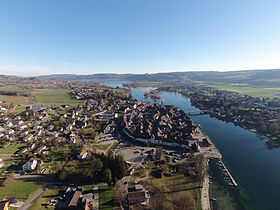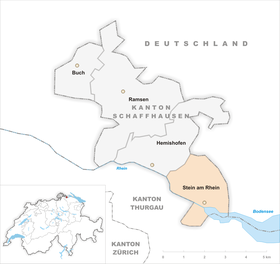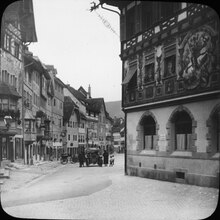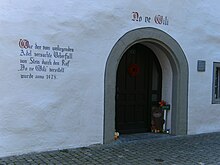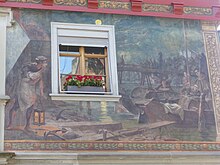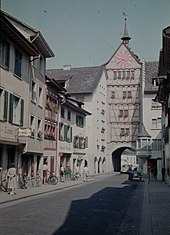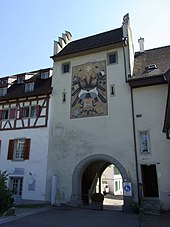Stone at the Rhein
| Stone at the Rhein | |
|---|---|
| State : |
|
| Canton : |
|
| District : | stone |
| BFS no. : | 2964 |
| Postal code : | 8260 |
| Coordinates : | 706 731 / 279 711 |
| Height : | 413 m above sea level M. |
| Height range : | 394–620 m above sea level M. |
| Area : | 5.78 km² |
| Residents: | 3415 (December 31, 2018) |
| Population density : | 591 inhabitants per km² |
| Website: | www.steinamrhein.ch |
|
Stone at the Rhein |
|
| Location of the municipality | |
Stein am Rhein (in the local dialect Staa, formerly Latinized Lithopolis or Gaunodurum ) is a political municipality in the so-called upper canton of the Swiss canton of Schaffhausen . Stein am Rhein is mainly known for the well-preserved old town center and is therefore very popular with tourists.
geography
location
Most of the city is located to the north or on the right bank of the High Rhine at around 413 m above sea level. M. , where the Rhine flows out of Lake Constance . Stein am Rhein is the only municipality in the canton of Schaffhausen with access to Lake Constance and, with a bridgehead, a well-known area south of the Rhine. The eastern and northeastern municipal boundaries are also the border between Germany and Switzerland .
Districts
There are two districts in Stein am Rhein: "Stein am Rhein" and "Stein am Rhein vor der Brugg". To the north of the Rhine are the old town, the school, the monastery, Hohenklingen Castle and the residential areas of Oberdörfli, in Boll, Niederfeld and Klingenried. The station, the larger part of the industrial area, in which the Coop and Migros shopping centers are located, as well as the residential areas Espi, Burg, Burgacker, Degerfeld, Köhlerweid and the station district are located in the south of the Rhine, “Stein am Rhein vor der Brugg” including train and bus station. As a curiosity, belonging to a district also affects the tax rate (reformed church tax ).
history

Archaeological finds as well as a fragmentary building inscription prove that in late antiquity a Roman border fortress (about 90 × 90 meters) called Tasgetium , which controlled a Rhine bridge and was occupied by limitanei , was located in what is now the city area . A settlement of the same name had existed since the 1st century, but the fortress was only built around 300 AD under Emperor Diocletian and was located to the left of the Rhine. Remains of the southern outer wall now form the boundary of a cemetery and are clearly visible. At the beginning of the 5th century further work was carried out on the fort . To the right of the river was a smaller bridgehead , and excavations around 1900 discovered a late Roman cemetery. A certain settlement continuity into the Middle Ages can be proven; several medieval buildings were built on the foundations of Roman structures. The Roman name of the place was forgotten.
The place was first mentioned as a town in 1267. At that time the landlord and market lord of the city was the St. Georgen Monastery . By the abbot was to manage the low jurisdiction a Schultheiss appointed to the developed one city council. The Reichsvogtei , that is the high jurisdiction and the team right, belonged first to the dukes of Zähringen , then to the castvogts of the St. Georgen monastery, the barons of Hohenklingen , and finally to the Klingenberg family .
The oldest town charter in Stein dates back to 1385. On January 22nd, 1457, the town authorities succeeded in acquiring the bailiwick rights from the Klingenberg and thus obtaining the status of imperial freedom . In 1459 Stein allied with Zurich and Schaffhausen in order to protect themselves from attacks by the Habsburgs . In 1468 the township adopted a constitution with a mayor, councilors, imperial bailiff (high court) and mayor (lower court). The guilds had no direct political say. Until the 16th century, Stein acquired a small subject area in the surrounding area; consisting of Hemishofen , Ramsen with Wiesholz, Wilen, Karolihof and Bibern , Wagenhausen with Bleuelhausen and Reichlingen.
On September 29, 1484, for financial and political reasons, Stein came under the patronage of Zurich and thus became part of the Swiss Confederation . As a result, the city did not succeed in acquiring patronage over the St. Georgen Abbey, as Zurich preceded it. After the abolition of the monastery during the Reformation , Zurich gradually built up its sovereignty over Stein as the legal successor to the monastery .
In 1512 the city received from Pope Julius II a valuable « Juliusbanner » for the services rendered in the "Great Pavier Campaign" in 1508–1510 to expel the French.
Affiliation with Zurich ended in Helvetic Republic when Stein was attached to Schaffhausen in May 1798. Although Stein tried to return to Zurich in 1802, he finally had to accept his membership in Schaffhausen when the mediation constitution came into force in 1803.
In the Middle Ages and the early modern period, stone was primarily of strategic importance, as it had one of the few bridges over the Rhine. During the Swabian War , Stein became a gateway into the Hegau for the Confederates . During the Thirty Years' War the Swedish general Gustaf Horn wanted to occupy the city of Constance , which was easier to do from the Swiss side. When Horn promised not to damage Stein am Rhein during a march through, the bridge watch under the commandant Martin Aufdermauer from Schwyz granted him the march on the night of September 7th to 8th, 1633. Kilian Kesselring later had to bear the consequences . The late medieval Rhine bridge was destroyed in fighting between Russians and French during the French era.
On February 22, 1945, an American bombing killed nine people and severely damaged several buildings. The surviving victims were compensated by the American government in the 1950s.

Until July 1999 Stein am Rhein was the main town in the district of the same name .
politics
The city has a government, the city council, and a parliament, the residents' council.
The part-time, five-member city council currently (as of September 2019) consists of the following people:
| Surname | Political party | presentation |
|---|---|---|
| Sönke bandixes | independent | City President (Presidial, School) |
| Thomas Schnarwiler | CVP | Works Advisor (Vice President, Works, Security) |
| Ulrich Böhni | GLP | Finance Officer (Finance) |
| Corinne Ullmann | SVP | Social Officer (Social Affairs) |
| Christian Gemperle | independent | Construction Advisor (Construction) |
The Steiner residents' council is the parliament of the community of Stein am Rhein and is elected by majority vote. The legislature lasts four years. The council has 15 seats. The following parties are represented in the council (values with slashes indicate changes in the course of the legislature):
| Political party | 2013-2016 | 2017-2020 |
|---|---|---|
| SP stone | 6 seats | 4 seats |
| SVP | 2 seats | 3/2 seats |
| FDP | 3 seats | 2 seats |
| ProStein | 2 seats | 1 seat |
| GLP | 0 seats | 0/1 seat |
| Free list | 1 seat | 0 seats |
| independent | 1 seat | 5 seats |
| total | 15 seats | 15 seats |
coat of arms
Blazon and Importance
Blazon : In red the blue armored St. George with a yellow nimbus and cross shield on a white horse, killing the green dragon. The Holy St. George is the patron saint of Stein am Rhein. On the coat of arms he can be seen fighting a dragon . The church of the Benedictine monastery in Stein am Rhein is dedicated to St. George. He is found for the first time in 1295 on the seal of the chapter , standing in the right hand with the battle flag and the left on the cross shield. The seal of the convent shows in a seal from the same time the riding George as a dragon slayer. The city adopted this image for its seal, which can be traced back to 1327. Over the next few centuries this image persisted and underwent only slight changes. If Georg kills the dragon in the oldest depictions with a spear from a horse, he now does so with a sword or without a horse. Since the coat of arms was only subject to minor changes, only the tincture had to be finally determined during the adjustment in 1951. The oldest traditional depiction of St. George on horseback, piercing the lindworm with a spear, served as a template for the coat of arms.
Change of coat of arms
On February 19, 2003, the city council of Stein am Rhein passed the decision in principle that the expert opinion of the “Swiss Coats of Arms and Flags Foundation” of January 12, 2003 must be followed. The report states that, as is well known, only one side of the coat of arms is to be viewed and that figures usually always look to the heraldic right. The left position is not forbidden, but must be mentioned in the blazon. However, since this was never the case, it was decided to change the coat of arms (only a horizontal reflection of the old coat of arms) as well as the flags.
traffic
The station is located on the left bank of the Rhine and is the only station in the canton of Schaffhausen south of the Rhine. There are connections to Schaffhausen, Winterthur and along Lake Constance via the lake line to Romanshorn and on to Rorschach and St. Gallen . The railway network is operated by Thurbo AG.
Stein am Rhein is the terminus of the Stein am Rhein - Frauenfeld , Stein am Rhein - Singen and Stein am Rhein - Radolfzell bus routes .
Between April and October Stein am Rhein is called at several times a day by the URh Schweizerische Schifffahrtsgesellschaft Untersee und Rhein .
Culture
The "No-e-Wili-Verein" in Stein am Rhein performs the open-air play No e Wili about the salvation of Stein am Rhein at irregular intervals .
The NordArt Theater Festival has been held annually since 2008.
The Lindwurm Museum is located in the old town of Stein am Rhein. On more than 1500 m 2 the museum shows middle-class living in connection with agricultural work. The house reflects the typical way of life around 1850 in Stein am Rhein. In 1995 the Lindwurm Museum was awarded a special prize as “European Museum of the Year”.
The Chretzeturm artist residence in Stein am Rhein has existed since 1999. Four international artists from all fields are invited annually for three-month guest stays.
In the city there are many clubs that are broadly diversified, such as the Stadtmusik Stein am Rhein, the Guggenmusik Staaner Schränzer as well as various shooting clubs and gymnastics clubs.
The Espi lido is located on the left bank of the Rhine.
tourism
Many medieval buildings shape the picture - the painted facades, half-timbered houses, bay windows and small alleys are the tourist potential of this city. In 1972 the community received the first Wakker Prize for the exemplary maintenance of the townscape .
Since 2000 there has been a market in Stein am Rhein in the run-up to Christmas, which is known as the fairytale town. There, the old town is decorated for Christmas and along the Märliwegs tells a fairy tale. Many stands - especially with local products - as well as a medieval and a western weekend complete the offer.
Attractions
Old town
- Towers and gates delimit the old city. The witch tower on the Schiffsländi can be traced back to 1548. The "Untertor" on the west side was first mentioned in 1367 and guarded the road to Hegau. The "Obertor" is attested in 1363.
- The facade paintings are of quite different ages. The oldest in the house "Weisser Adler" dates from 1520/1525, is considered to be the earliest preserved facade painting in Switzerland and shows a. a. Motifs from the Decameron by Giovanni Boccaccio and from the Gesta Romanorum .
- The particularly eye-catching wall frieze on the “Sonne” house, on the other hand, was not created until 1900 and shows the famous episode from antiquity in which the philosopher Diogenes said to Alexander the Great : Get out of the sun.
- The former St. Georgen monastery is now a museum, and the church is used as the town church by the Reformed community. Also noteworthy is the Reformed St. John's Church at the castle.
- The citizen's asylum is located in the former “Hospital of the Holy Spirit” from the 13th century in the upper town. After renovation between 1999 and 2002, it is used as a city archive and tourist information.
- The Lindwurm Museum is located in a medieval house with an empire facade in the old town of Stein am Rhein. On 1,500 m 2 , the Lindwurm Museum presents middle-class living and agricultural work in the 19th century.
Outside the old town and suburbs
- Remains of the Roman fort Tasgetium with St. John's Church in the Burg district on the left bank of the Rhine
- Hohenklingen Castle , about 200 m above the city
- Werd archipelago ( Old High German Werid ) - a previously huge gneiss rock , which gave the city its name (municipality of Eschenz )
- Propstei Wagenhausen , left bank of the Rhine (municipality of Wagenhausen )
natural reserve
At the lower end of the Untersee from Mammern to Stein am Rhein (including the Swiss border on the right) lies the “Untersee and Rhein water and migratory bird reserve”. It enables, among other things, the wintering of golden-headed , tufted and pochard ducks .
Personalities
- Johannes Hospinianus (1515–1575), philosopher
- Gotthard Heidegger (1666–1711), theologian
- Johann Heinrich Meister (1700–1781), theologian
- Johann Georg Fuog (1794–1865), politician
- Johann Georg Böschenstein (1804–1885), politician and judge
- Rudolf Ulrich Krönlein (1847–1910), surgeon
- Robert Gnehm (1852–1926), chemist
- Hermann Knecht (1893–1978), painter
- Ernst Lieb (1898–1989), politician
- Hugo Boeschenstein (1900–1983), graphic artist
- Walter H. Schaad (1902–1990), architect
- Willy Guhl (1915–2004), furniture designer, product designer and interior designer
- Mathias Gnädinger (1941–2015), actor and voice actor
- Rico Wenger (1944–2002), politician
- Peter Heinzer (1945–2015), graphic artist and painter, born in Stein am Rhein
- Thomas Böhni (* 1964), politician
- Hildegard Urner-Astholz (1905–2001) art historian
gallery
literature
- Christian Birchmeier: The field measurement art of the 18th century using the example of Stein am Rhein. In: Cartographica Helvetica. Issue 15, Murten 1997, pp. 11-21. Full text
- Heinrich Boxler: Hohenklingen. In: Historical Lexicon of Switzerland .
- Erwin Eugster, Michel Guisolan, Katja Hürlimann, Adrian Knoepfli, Dieter Füllemann: Stein am Rhein - history of a small town. Stamm, Schleitheim 2007, ISBN 3-9523132-1-1 (Attention: The ISBN is assigned twice!).
- Michel Guisolan: Stein am Rhein. In: Historical Lexicon of Switzerland .
- Michel Guisolan, Roman Sigg: Stein am Rhein (= Swiss Art Guide. No. 932, Series 94). Edited by the Society for Swiss Art History GSK. Bern 2013, ISBN 978-3-03797-114-7 .
- Michel Guisolan: Stein am Rhein (= Swiss Art Guide. No. 625/627, Series 63). Edited by the Society for Swiss Art History GSK. Bern 1998, ISBN 978-3-85782-625-2 .
- Ulrich Büttner, Egon Schwär: Bodenseegeschichte (s) excitingly told, ISBN 3-7977-0587-5
Web links
- Official website of the municipality of Stein am Rhein
- Burgenwelt: City fortifications Stein am Rhein
Individual evidence
- ↑ Permanent and non-permanent resident population by year, canton, district, municipality, population type and gender (permanent resident population). In: bfs. admin.ch . Federal Statistical Office (FSO), August 31, 2019, accessed on December 22, 2019 .
- ↑ Winfried Hecht: The Julius banner of the town facing Rottweil. In: Der Geschichtsfreund: Messages from the Central Switzerland Historical Association . 126/7 (1973/4). doi: 10.5169 / seals-118647
- ^ Karl Hirrlinger: The bombing of Stein am Rhein on February 22, 1945 and its connections. In: Heimatblätter of the historical association of Stein am Rhein, 6th year, 1982, quoted from Walter Hess | retrieval = 2020-08-02
- ↑ 70 years ago today, bombs fell on Stein am Rhein. (No longer available online.) In: St. Galler Tagblatt. February 22, 2015, archived from the original on August 5, 2017 ; accessed on August 5, 2017 .
- ^ Website of the municipality of Stein am Rhein: City Council. Retrieved August 2, 2020 .
- ^ Website of the municipality of Stein am Rhein: Residents' council. Retrieved August 2, 2020 .
- ^ Website of the municipality of Stein am Rhein: Residents' council. Retrieved August 2, 2020 .
- ^ Joseph M. Galliker: Swiss coats of arms and flags . tape 9 . Zug 2006, ISBN 978-3-908063-09-4 , pp. 78-79 .
- ^ Berty Bruckner-Herbstreit: The emblems of the state Schaffhausen and its communities. Reinach-Basel 1951, pp. 278-303.
- ↑ City Council Minutes of 19.02.2003 . Session 05/2003. Stein am Rhein 2003, p. 116-117 .
- ^ No e Wili association. Retrieved August 2, 2020 .
- ↑ Chretzeturm. In: Website of the municipality of Stein am Rhein. Retrieved August 2, 2020 .
- ↑ Stadtmusik Stein am Rhein. Retrieved on August 2, 2020 (Swiss Standard German).
- ↑ Staaner Schränzer. Retrieved on August 2, 2020 (German).
- ↑ Associations. In: Website of the municipality of Stein am Rhein. Retrieved August 2, 2020 .
- ↑ Espi swimming pool, Stein am Rhein. Retrieved August 2, 2020 .
- ↑ Swiss Homeland Security | Overview since 1972. Accessed August 2, 2020 .
- ↑ The fairytale town of Stein am Rhein. Retrieved on August 2, 2020 (Swiss Standard German).
- ↑ Michel Guisolan and Roman Sigg, see Bibliography, p. 49
- ↑ Michel Guisolan and Roman Sigg, see Bibliography, p. 43
- ↑ https://www.klostersanktgeorgen.ch/
- ↑ Christoph Buff, Kurt Bänteli: The Johanneskirche in Burg, Stein am Rhein. (Swiss Art Guide, No. 868, Series 87). Ed. Society for Swiss Art History GSK. Bern 2009, ISBN 978-3-85782-868-3 .
- ^ The citizen asylum in Stein am Rhein. In: Alexander Pohle: 99 x Lake Constance as you don't know it yet. Bruckmann Verlag 2014, ISBN 978-3-7654-8303-5 . P. 120.
- ↑ Adventure - Museum Lindwurm. Retrieved August 2, 2020 .
- ↑ Information board of the Thurgau bird protection on the left bank of the Rhine from Stein am Rhein.

